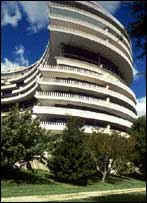|
|
|
"Watergate" is a general term used to describe a complex web of
political scandals between 1972 and 1974. The word specifically refers to
the Watergate Hotel in Washington D.C.
|
|
Richard M. Nixon is one of the most fascinating political figures of the
20th century.
His long political career began in 1947 when he was elected to the House
of Representatives. By 1952 Nixon had been chosen as Dwight Eisenhower's
vice-presidential running mate, but nor before he was embroiled in a
scandal that led to the infamous Checkers Speech. |
|
Nixon served as vice-president for eight years, then lost the 1960
election to John F. Kennedy. He recovered from political defect to be
chosen again as the Republican Party's candidate at the 1968 election.
Following a year of turmoil, including two political assassinations, Nixon
became the nations 37th
president on January 20, 1969. Later that year, he delivered his Silent
Majority speech on the Vietnam War, articulating his belief that the
bulk of the American people supported his policies and program. He was
vindicated by winning a landslide re-election. he was sworn in for a
second term in January 1973.
|
|
Watergate has entered the political lexicon as a term synonymous with
corruption and scandal, and yet the Watergate Hotel is one of Washington's
finest hotels. It was here that the Watergate Burglars broke into the
Democratic Party's National Committee offices on June 17, 1972. If it had
not been for the alert actions of Frank Wills, a security guard, the
scandal may never have erupted. |
|
The story of Watergate has an interesting and political background,
arising out of political events of the 1960s such as Vietnam. But the
events of the scandal really begins during 1972, when the burglars were
arrested. by 1973, Nixon had been re-elected, but the storm clouds were
building. By early 1974, the nation was consumed by Watergate. |
| Nixon made three major speeches on the Watergate scandal during 1973 and
1974. The first was on April 30, 1973 in which he announced the departure
of Dean Haldeman and Ehrlichman. A more defiant speech was the one on
April 29, 1974, in which Nixon released partial transcripts of the White
House tapes. |
|
Investigations of Watergate were heavily influenced by the media,
particularly the work of two reporters from the Washington Post, Bob
Woodward and Carl Bernstein, along with their mysterious informant John
Sears. (deep throat) |
|
Political investigations began February 1973. The senate established a
Committee to investigate the Watergate scandal. The public hearings of the
Committee were sensational, including the evidence of John Dean, Nixon's
former White House Council. The committee also uncovered the existence of
the secret White House tape recordings, sparkling a major political and
legal battle between the Congress and the President.
Bob Woodward (right) |
 |
| In 1974, the House of
R. Nixon's last days in office came in late July and early August 1974. The
House of Committee voted to accept three of the four proposed Articles of
Impeachment, with some Republicans voting with Democrats to recommend
impeachment of the president. representatives authorized the Judiciary Committee
to consider impeachment proceedings against Nixon. The work of this
committee was again the spotlight a quarter of a century later when Bill
Clinton was impeached. |
|
The final blow come with the decision by the Supreme Court to order Nixon
to release more tapes. One of these became known as the Smoking Gun
tape when it revealed that Nixon had participated in the Watergate
cover-up back in June 1972. Around the country there were calls for Nixon
to resign including one from an Arkansas congressional candidate and
future president. |
| At 9pm on the evening of August 8, 1974, Nixon delivered a nationally
televised resignation speech. The next morning, he made his final remarks
to the White House staff before sending his resignation letter to the
Secretary of States. |
|
Darcy Worley
8th
American History
Rossville Jr. High
Post-World War II America Project
May 2002 |
Bibliography |



